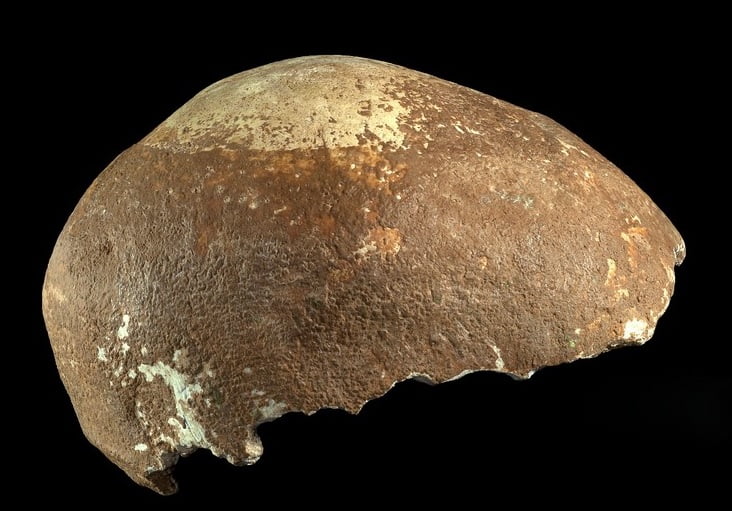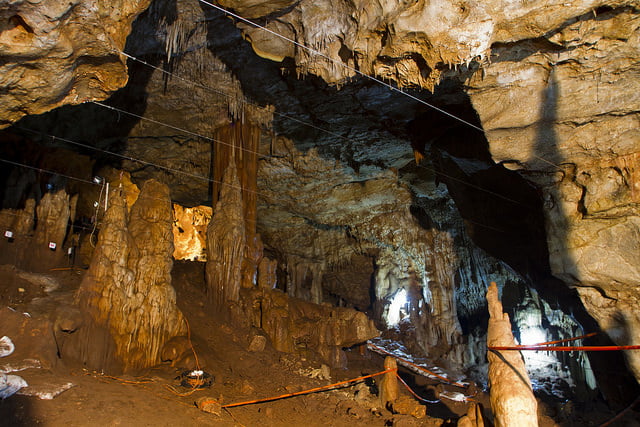An ancient human skull found in Israel could be one of the most important discoveries in understanding the history of human evolution. The 55,000-year-old skull found inside Manot Cave in northern Israel seven years ago was recently declared the oldest skull found outside of Africa. This rare fossil indicates that homo sapiens, our human race, originated in East Africa and migrated to the Middle East about 50,000-70,000 years ago.
The skull was accidentally discovered in the Western Galilee in 2008 when an unknown cave that had been sealed off for at least 30,000 years was exposed by a bulldozer operator. Inside of the cave, researchers from Israeli universities discovered a calcite-covered fragment of a small, anatomically modern human skull.
“This is a goldmine,” Tel Aviv University’s Prof. Israel Hershkovitz, who leads the research of the skull, stated. “Most other caves are ‘disturbed caves,’ but this is untouched, frozen in time — truly an amazing find.” Hershkovitz lead the research team analyzing the skull, working jointly with the Israel Antiquities Authority and Ben Gurion University, but news of the discovery quickly spread. Anthropologists, archaeologists, geologists and other scientists from around the globe made their way to Israel to study the skull and the cave due to the important implications of the discovery.
SEE ALSO: Tel Aviv Researchers Reveal Why Thriving Civilizations Perished 3,200 Years Ago In The Levant
There are competing theories on how modern humans came to populate the Earth. One of these, called the assimilation model, proposes that modern humans bred with archaic human populations, such as Neanderthals, to form hybrid groups who were absorbed into larger modern human populations. Strong genetic support for a version of this model came in 2010 from Leipzig-based evolutionary geneticist Svante Pääbo, who presented a draft sequence of a Neanderthal genome. His analysis showed that the ancestors of non-African people interbred with Neanderthals in the Middle East – before they migrated to Europe and Asia – sometime between 50,000 to 100,000 years ago. Another genetic analysis of 45,000-year-old DNA from a Siberian thighbone published last year further narrowed the likely interbreeding time to between 52,000 to 58,000 years ago. However, no one has been able to corroborate these findings with physical clues, until Hershkovitz concluded his study of the prehistoric skull in January.
The only cohabitation of Neanderthals and modern humans
Sign up for our free weekly newsletter
SubscribeIn a paper recently published in “Nature,” Hershkovitz and his co-authors claim they have found the missing fossil evidence. The skull was discovered just a few dozen kilometers from other caves where Neanderthal remains from the same time period had been identified. “When the Manot people came to Israel, they encountered a flourishing population of Neanderthals, with whom they must have communicated, shared tools and interbred with,” Hershkovitz said in a statement. “According to our analysis of the skull, which bears a complex mix of archaic and modern characteristics, this was probably the only place on earth where Neanderthals and anatomically modern humans lived side by side for a long period of time.”
SEE ALSO: Ancient Copper Smiths Were Aristocrats – Not Slaves – Israeli Archaeologists Find
The skullcap (or calvarium), is complete enough to indicate a lineage from modern humans in Africa to the people of the Manot cave, and on to later European human populations. “When we analyzed the morphology of Manot skull, we made two important discoveries,” Hershkovitz recalls. “First, we found African affinities, confirming that the Manot population originated in Africa. Second, we noted many morphological peculiarities akin to early Upper Paleolithic populations in Europe, which suggest ancestral connections to earlier European populations. All of this confirms that people in Manot came from Africa, stayed in Israel for several thousand years, and later, when weather conditions improved, moved to Europe. The Manot people are indeed the ancestors of European populations.”
The research team expects that additional fossils will be found in the Western Galilee area of Israel during future excavations.

Photos: Israel Antiquities Authority/Clara Amit, Simon Fraser University
Related posts

Resilient And Nutritious New Plant-Based Milk Aims To Make A Splash

Chocolate From Cultivated Cocoa Comes Without Environmental Toll

Plastic Fantastic: Startup Takes PVC Back To Its Crude Oil Roots





Facebook comments